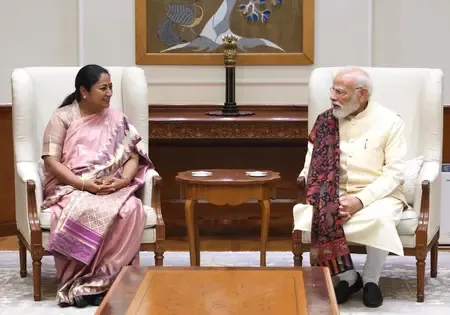Has India's retail asset securitisation market grown by 6% in Q1 FY26?

Synopsis
Key Takeaways
- India's retail asset securitisation market grew by 6% in Q1 FY26.
- The total transaction volume reached Rs 52,000 crore.
- PTC transactions now constitute 56% of the total volume.
- RMBS is emerging as a critical area for innovation.
- Microfinance Institutions are gaining traction with increased issuance.
New Delhi, July 9 (NationPress) The retail asset securitisation landscape in India has exhibited consistent growth during the first quarter (Q1) of FY26, with an impressive transaction volume reaching Rs 52,000 crore, as revealed in a report released on Wednesday.
This figure encompasses both pass-through certificate (PTC) issuances and direct assignment (DA) transactions, according to the report from CareEdge Ratings.
The volume signifies a 6 percent increase compared to the same timeframe last year.
Despite the fluctuations, the market's stability serves as an encouraging indicator, fueled by robust demand for credit, investor confidence, and the strategic initiatives of originators to diversify their funding channels.
A pivotal achievement in Q1 FY26 was the completion of India's inaugural residential mortgage-backed securitisation (RMBS) transaction, executed by RMBS Development Company Limited (RDCL).
This transaction also marks the first securitisation deal to be conducted via the Electronic Book Provider (EBP) platform, signaling a transformative phase in India’s securitisation sector.
This landmark deal could potentially attract more investors into the RMBS market, thereby fostering innovation and increasing participation in mortgage-backed securities.
The expected outcome is an expansion of long-term funding avenues and enhanced risk transfer mechanisms.
Analyzing the transaction composition in Q1 FY26 reveals a significant shift. PTC transactions currently account for 56 percent of the overall volume, a notable change from previous periods when direct assignment (DA) transactions held a more substantial share.
This rise in PTCs likely mirrors evolving investor preferences, regulatory influences, and a growing appetite for more standardized and tradable financial instruments.
This transition also indicates that originators aim to appeal to a wider investor demographic.
Among the PTC issuances, asset-backed securitisation (ABS) products played a significant role, constituting approximately 75 percent of the total volume.
Meanwhile, mortgage-backed securitisation (MBS) maintained a steady presence at 10 percent. A noteworthy highlight in Q1 FY26 was the increase in PTC issuances from Microfinance Institutions (MFIs), which contributed 15 percent of the total PTC volumes, a substantial rise from 8 percent in Q1 FY25.
This growth underscores improved asset quality stability in the microfinance sector and suggests a rise in investor confidence in this domain.
Within the ABS category, vehicle loan financing remained a significant contributor, accounting for over Rs 14,600 crore, or 51 percent of total PTC issuances in Q1 FY26. This encompasses loans secured by various vehicles, including commercial trucks, passenger cars, two-wheelers, and construction machinery, as detailed in the report.
However, the share of vehicle loans has seen a decline in comparison to preceding quarters, as other asset categories like unsecured personal loans, business loans, and gold loans have gained traction.
Unsecured loans alone represented 15 percent of total PTC issuances, indicating a rising interest from investors in these alternative retail credit segments.
In the DA sector, mortgage-backed transactions continued to lead, constituting 67 percent of the total DA volumes in FY25. Asset-backed DA transactions made up 26 percent, as reported.









